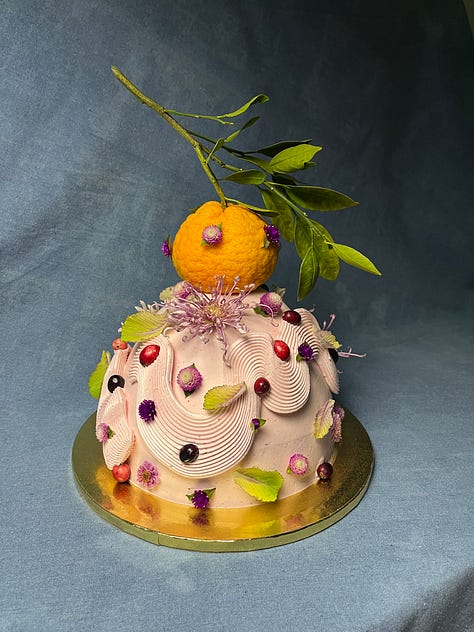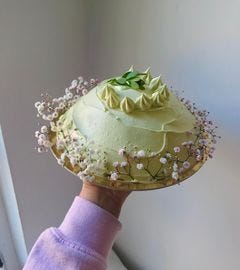A Dome Cake for Everyone!
All about my new online class
Ok I have to put my sales pitch hat on for this one- feels real weird but I appreciate your patience! Today’s newsletter is all about my new online cake decorating class. I’ve been working on it for months with my collaborator Drew Stubbs, an incredibly talented videographer, director and editor. He is also famously married to one of my bff’s, Liz - they had the most fun wedding I have ever been to (Stormy Daniels was there reading tarot!).
Drew did an excellent job teasing out more information and context from me as we filmed this video, and his editing skills are bananas. This is the first of many classes we’re planning, so if there’s a skill you’re particularly keen to learn, let me know!
Read on for more details about our dome cake class. You can find the link to shop the class here. Newsletter readers get a 10% discount with the code DOWNTODOME. (Edited to add: my wife just had to break it to me that that the discount code reads both down-to-dome and down-to-do-me, so we’re definitely going to be running our codes past her in the future!).
You can also scroll down to the bottom of this newsletter for a list of tools I recommend for the class - including links to the versions I personally use (not affiliate links but feel free to reach out, webstaurant.com!).
During the great 2020 Pandemic Cake Renaissance, I was browsing Instagram and saw an image that stopped me in my tracks. I can describe it from memory: a pale green cake, just barely kissed with a whimsical star tip and baby’s breath, in the most fetching shape: a dome. Far from the fussy full-skirted Barbie domes of my childhood, this cake was spare and unusual. This elegant creation had been baked by Natasha Pickowicz, one of the central pastry auteurs behind the explosion of naturalistic cakes these past four years.
I knew I wanted to try it for myself, and immediately bought a dome shaped cake pan. This was my first mistake. It’s nearly impossible to properly bake a cake in a bowl. Even a well-insulated concave cake pan made for the purpose, such as this one, will produce a cake with a too-dry exterior and a two-custardy interior. Remember, bundt pans are built with a center hole for a reason. Natasha has perfected her own process for assembling a cake bombe, by cleverly layering very thin layers of sponge cake in a bowl with stable fillings - you’ll have to check out her debut cookbook More Than Cake for that method. I’m here to present you with a different approach.
My new class, A Dome Cake for Everyone, is a step-by-step guide to my process for building, covering, and decorating dome cakes. I’ll give you recipes for my favorite almond olive oil cake, a simple lemon curd, a custardy cake filling, and Swiss meringue buttercream - all easily customizable to your tastes. I’ll show you step-by-step how I crumb coat the cake, prepare the buttercream for its silky final coat, and then shape it to a glossy, curved finish. To finish, I demonstrate three different piping techniques - the wide basketweave tip, a classic Bayou Saint Cake squiggle, and a large buttercream ruffle.
You won’t need to follow my recipes exactly, or even at all, to master the techniques I talk about in the class. Feel free to use your favorite cake recipe or whatever filling you like. If you’d like to make a dome cake in a different shape by using different sized pans, you can use my method to achieve a wide variety of sizes and looks for your dome.
For more inspiration, check out the evergreen dome cake roundup Bettina Makalintal wrote for Eater in 2022 - probably one of my favorite articles ever written about Internet Cake Club.






This class may be best for moderately experienced cake makers, who have stacked a layer cake in the past and are generally familiar with the ins and outs of baking. However, I genuinely believe that with practice, anyone can achieve these effects. I should also note: the recipes in this class are available in both volume and grams, but I think your baking will improve if you use a scale.
A note: you’ll receive an email with a link to download the class when you purchase it, so make sure you’re using an email you have access to. The download will come in the form of a digital zine, and the video will be embedded on the second page. Feel free to email or comment if you have any questions!
Following is a list of tools that you will need to successfully achieve the techniques and recipes shown in class. It looks long, but if you’re an avid home baker, you probably already have most of them!
Tools you’ll need for class
A digital scale - these are great, or level up with this one. If you’re a cottage baker baking at high volume, definitely spring for the latter scale with its 11 lb / 5kg capacity. (Note: I include volume measurements as well, so you don’t actually really need a scale, but your baking will improve if you get one).
A stand mixer with a whisk attachment. I have this one, but you can definitely get a smaller one if you’re a home baker. I got mine on sale at Cosco, FWIW.
A medium sized pot, for boiling water (ideally, the bowl of your mixer will fit snugly in the pot).
A digital thermometer. You don’t need a fancy one, but I went through countless cheap ones before breaking down and buying a thermapen, which I’ve never had to replace.
A whisk and a rubber spatula.
Three 6” cake pans (if you’d like to bake the cake I demonstrate in the class - you don’t have to!).
Parchment paper.
A medium sized bowl or two.
A sturdy cake turntable.
A metal cake scraper: preferably like this one, or this one (for the latter, we’ll only be using the straight edge). In my practice I prefer the longer scraper, as it has a nice weight in the hand and the height is handy for taller cakes. You can also use a bench knife, though the handle will sometimes get in the way of producing a nice right angle at the base of your cake. Do not be tempted by acetate cake scrapers: we’ll be warming ours to help smooth the cake, so we’ll need the metal. I’ve also found acetate gets banged up super quickly, and any rough edges will ding your cake.
A short offset spatula.
A long offset spatula.
A tall container that you can use to store your offset spatulas and cake scraper in warm water - perhaps a wide mouthed mason jar, or a tall liquid measuring cup.
Some tools that are handy but not essential:
A butane torch. Skip the ones that appear to be made for kitchens - no one uses those types in professional spaces, and I’ve found they break easily. Buy one from a hardware store and it will last forever.
A wide basketweave tip (if you’d like to try that affect)
A narrow plain tip (if you’d like to try a squiggle)
An oven thermometer - chances are your home oven isn’t perfect, so you may need to adjust the heat up or down a bit to properly bake your cakes.






definitely read it as "down to do me"
Omg this is amazing. Dome cakes are famously difficult (I’m assuming that’s why rarely anyone bakes them) and as a curious baker myself I would love to try!